Geodes
On the outside they look ordinary, but inside they're extraordinary!
Article by: Hobart M. King, PhD
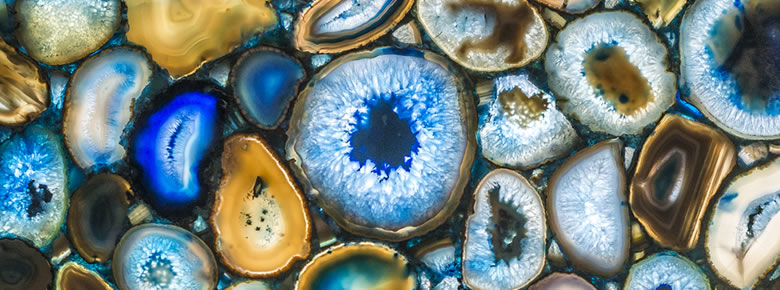
Geode wall panel: A portion of a large backlit wall panel made using thin translucent slices from many types of geodes instead of stained glass. The blue color in many of the geodes was produced with dye. Image copyright iStockphoto / Klod.
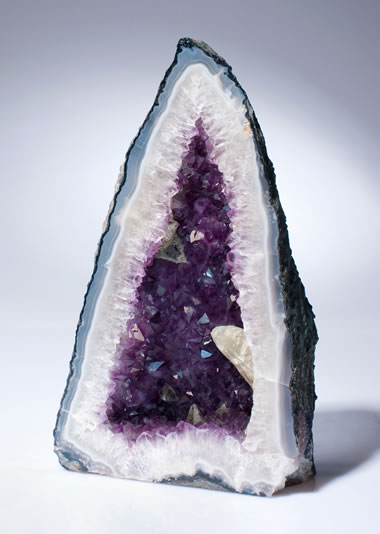
Amethyst cathedral geode: A very high quality amethyst cathedral geode with a natural artistic shape and richly colored amethyst. It also has a dogtooth calcite crystal grown inwards from the lower right wall. Image copyright iStockphoto / simarts.
What Are Geodes?
Geodes are spherical to subspherical rock structures with an internal cavity lined with mineral materials. They have a durable outer wall that is more resistant to weathering than the surrounding bedrock. This allows the geode to survive intact when the surrounding bedrock weathers away. The mineral lining the cavity is often a scintillating druse of tiny quartz crystals underlain by multiple bands of translucent gray and white agate. Many are lined with more spectacular treasures.
Rich purple amethyst, perfect white calcite crystals, and colorful banded agate are other common linings. Rare geodes can be filled with beautiful blue gem silica, pink rhodochrosite, spectacular opal with vivid play-of-color or other rare materials. Geodes range in size from under one centimeter to several meters in length. From the outside most geodes look like common rocks, but when they are opened the sight can be breathtaking.
The Public’s Love Affair With Geodes
Most geologists enjoy geodes. However, the general public has a love affair with them. They are delighted and amazed that an uninteresting rock can contain a beautiful cluster of gemmy crystals, or a colorful lining of banded agate, or both of those in the same cavity. Broken open, or sawn and polished, people who have never taken a geology course buy thousands of tons of geodes each year. They buy them because they enjoy them. They love tiny geodes as jewelry, sawn and polished geodes as bookends, and spectacular amethyst geodes as items of home or office decor.
In several parts of the world, geode localities have spawned profitable industries that collect them, prepare them for market, and ship them to destinations where they are purchased as items of science, natural art and enjoyment. Brazil, Uruguay, Mexico, and Namibia are four examples of countries where geodes have become a local industry.
Geodes sell rapidly at gem and mineral shows, science museums, rock shops, art galleries and shops that feature international or natural gifts. When geode-opening demonstrations are given at rock and mineral shows, they always draw a crowd -- and that crowd usually produces enthusiastic cheers and gasps when a nice geode is opened. There is something special about a beautiful treasure hiding in a rock that looks absolutely ordinary from the outside.
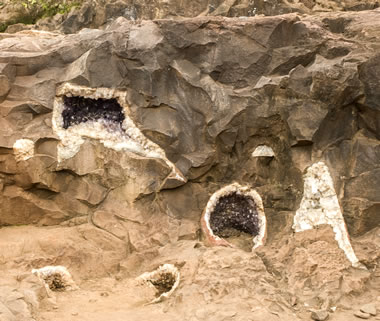
Geodes in basalt: An outcrop of a basalt flow exposing several open amethyst geodes. This photo illustrates how geodes can occur in large numbers within a single rock unit. Image copyright iStockphoto / yio.
Geologic Occurrence and Formation
Geodes are not found randomly here and there. Instead they are usually found in large numbers in areas where the rocks have formed in a special geochemical environment. Most geodes localities are in A) stratified volcanic deposits such as basalts and tuffs; or B) stratified sedimentary carbonate deposits such as limestones and dolomites. A diversity of other environments yield a small number of geodes.
Geodes form in many different ways, and there are a number of valid theories about their formation. The intent of this article is not to provide a single or a comprehensive coverage of the many ways that geodes might form.

The Story in the Rock: A spectacular sawn and polished geode specimen with multiple layers of colorful agate and a crystal-filled central cavity. Each colored band represents an episode of agate formation and a change in the composition of the groundwater that delivered mineral material into the geode. Image copyright iStockphoto / WojciechMT.
Volcanic Geodes
The most widely known and sought-after geodes are those that formed in areas of volcanic activity. Voids in basaltic lava flows often are infilled with agate, quartz, opal and other material delivered by hydrothermal water or groundwater. Some voids are spaces occupied by gases that failed to escape the lava flow before its surface crusted over.
Where does all of the gas come from? Some magmas contain a lot of dissolved gas. They can be several percent dissolved gas on the basis of weight. (Think about that - several percent gas by weight!) When these magmas ascend to the surface, the gas expands in proportion to the pressure reduction. When the magma erupts as a lava flow, so much gas is released that not all of it is able to escape. Some of that gas can be trapped in the lava to produce a large cavity when the lava solidifies.
Other voids in solidified lava flows were produced as liquid lava flowed out after the flow was only partially solidified. These small "lava tubes" produce some of the largest and longest geodes. Many cathedral geodes are branches of these lava tubes that later infilled with mineral material. Many of them have the geometry of long tree branches, being nearly a meter in diameter and many meters in length.

Breaking a Geode: An exhibitor at a gem and mineral show preparing to break a geode. The device used for breaking geodes looks like a long-handled bolt cutter. However, the pair of blades used to shear the bolt is replaced by a chain that is tightened around the geode until it breaks cleanly in half. Geode-cutting demonstrations usually attract a cheering crowd at gem and mineral shows. Image by ilovebutter, displayed here under a Creative Commons License.
Sedimentary Geodes
Geodes in sedimentary rocks are usually found in limestones, dolomites, and calcareous shale. In these deposits a gas-filled void can serve as the opening for geode formation. Shells, tree branches, roots and other organic materials often decay away to leave a void for the formation of mineral materials. These cavities can be filled with quartz, opal, agate or carbonate minerals. They are generally smaller than the geodes formed in volcanic rocks.
Geodes are most easily collected when their host rocks have weathered away. This can occur because basalt, limestones, dolomites, and shales weather much more readily and rapidly than the quartz and chalcedony that typically form the outer layer of a geode. The host rock weathers away and the geodes are left on the surface, washed into a stream, or stranded in a residual soil. In these situations the geodes are easily found and collected. Some geodes are produced by mining the host rock, but that method is difficult, costly, and often damages the geode.
Naming Geodes
Geodes are given a variety of names. The word "geode" is often preceded by the name of the mineral material which has filled the geode. "Agate geode" and "amethyst geode" are examples. The word "geode" might also be preceded by a geographic or stratigraphic name. "Keokuk geode" and "Brazilian geode" are examples.
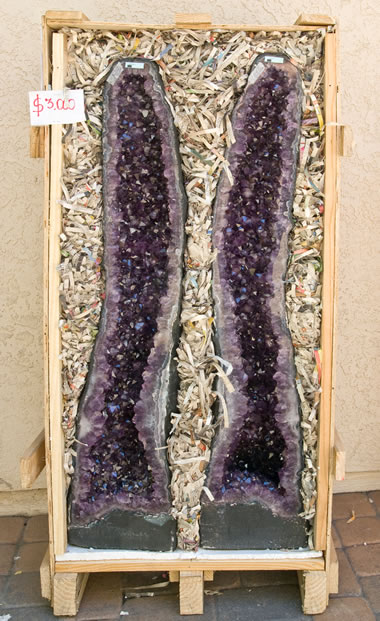
Geodes ready for shipment: Geodes from Brazil and other collecting localities are carefully crated to prevent damage during shipment. This photo shows a matched pair of cathedral geodes which are two halves of the same cavity. They have been given bases of heavy concrete that will enable them to be used as items of decor in a home or office. Image copyright iStockphoto / VYG.
Commercialization of Geodes
An unopened geode has the appearance of an uninteresting rock. They become much more interesting when they are opened and their internal crystals and agate bands become visible. And even though every crystal-lined geode is a wonder of nature, there are many things that can be done to make it into a more marketable product as well as enhance its value.
Museum-Quality Geodes
But, before we go any further, we want anyone who finds a really nice geode to know that museum-quality geodes are sold in the collector market for prices that will astound the average person. The Arkenstone, a business that specializes in museum-quality mineral specimens, usually has a few nice geodes for sale. At the time this article was being written, they were selling rare-mineral lined geodes featuring volkovskite, millerite, thomsonite, and shattuckite for four- and five-digit prices. You can see some of their inventory here.
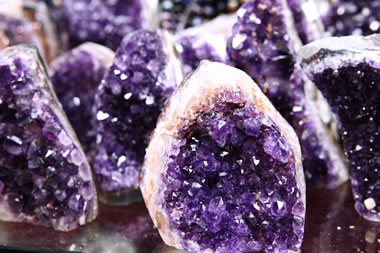
Amethyst geode sections: Small sections of amethyst geodes offered for sale in a tourist shop. Image copyright iStockphoto / danishkhan.
Utilitarian Geode Products
Large agate geodes are often cut into blocky pieces with a flat base to make beautiful bookends, desk sets, clock faces or paperweights. Those with gray, white, or other less-interesting agate colors are often dyed bright blue, green, purple, red or other colors and then face polished to make them more appealing. These treatments make the bookends sell faster and enhance their value beyond what would be paid for the less-interesting gray color.
Geodes as Items of Decor
Large amethyst-lined geodes are often expertly cut to display their internal amethyst crystals. They are then sawn and fitted with a weighted base to enable them to be used as an item of home or office decor.
Agate-lined sections of lava tube geodes have frequently been used to make "cathedral geodes" that are several feet high. These are cut in a way that nicely exposes the amethyst-lined chamber, they are then sawn to produce a flat base, which is filled with metal-weighted concrete to enable the geode to stand upright, the edges of the cavity are sanded for nice appearance, and the entire exterior is painted to hide the scrapes and scuffs that occurred during collection and transportation. Many of these large geodes sell for thousands of dollars each.
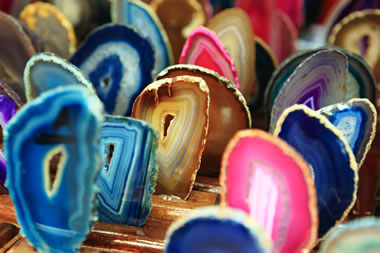
Dyed Geode Slices: These dyed geode slices have been mounted in wooden bases for display. Image copyright iStockphoto / danishkhan.
Geode Novelties
Small geodes are often sliced and polished. Especially nice slices might be displayed "as is" in specially-made frames or stands. Some have their translucent beauty displayed in stained-glass panels or windows like the example photo shown at the top of this page. Less spectacular specimens might be dyed and used to make wind chimes, coasters, or decorative magnets. Small sections of geodes with attractive and colorful crystals are often sawn into small pieces that will stand upright or into slabs that are used as display items.
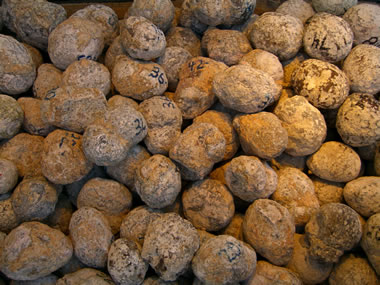
Small Geodes: Small geodes like these are often sold in novelty and science stores to people who want to have the experience of opening a geode themselves. They want to be the first human to see the treasure inside. Image copyright iStockphoto / leopardhead.
Break-Open-A-Geode Kits
Small, thin-walled geodes are often sold in kits by department, education, science, tourist and novelty stores. The vendor product descriptions encourage teachers, parents and students to purchase the kits and break the geodes open with a hammer. These geode kits are extremely popular. If you do a Google search for "geode kit" you will find them offered online by dozens of different vendors.
If you are tempted to purchase one of these kits, be sure to read the reviews because quality varies greatly. It is also essential to plan for proper safety equipment, because striking a geode with a hammer can produce flying rock fragments that can cause serious injury. You will also need a good place to do this activity. Following some of the vendor suggestions of breaking them on a table, or classroom floor, can cause property damage that is costly to repair.
An alternative to purchasing a "break-open-a-geode kit" every year is to purchase a few specimens of opened geodes and sliced geodes. This can be supplemented with looking at geodes on websites using computer projection and videos of professionals opening geodes on YouTube. These avoid the safety, property damage, and clean-up concerns of "breaking geodes." The cost of this approach might save money over time that can be used on other engaging science activities.
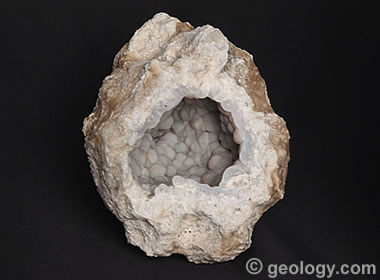
Geode Lined With Botryoidal Chalcedony: This geode was found in the Keokuk Region of Missouri which is famous for its geodes. This specimen is lined with bluish gray chalcedony that exhibits a beautiful botryoidal habit. It is approximately four inches across.
What? No Crystals?
Everyone expects to find bright, shiny, geometric crystals when they open a geode. But, sometimes there are other interesting landscapes inside. One of the most common finds when geometric crystals are not present is a geode lined with chalcedony, a microcrystalline variety of quartz.
Chalcedony crystals as so small that they cannot be seen with the unaided eye. In a geode, a tiny crystal of chalcedony will attach to the wall and it will be coated with a layer of tiny chalcedony crystals all pointing outwards from the seed crystal. Layer after layer is deposited, and the early result looks like a small hemisphere attached to the inner surface of the geode. These tiny hemispheres begin to grow into and over one another, and the result is a landscape that looks like a pile of grapes. This hemispherical geometry is a common crystal habit of chalcedony known as botryoidal. An example of a geode lined with botryoidal chalcedony is shown in the accompanying photo.

Fake geode: Photo of a galena-lined "geode" made from pottery clay decorated with paint and a covering of fine galena crystals. Purchased in Marrakesh, Morocco. Image copyright by Guy Courtois, displayed here under a Creative Commons License.
Fake Geodes
As with most popular or valuable objects, fake "geodes" have been manufactured by people and offered for sale as naturally-formed objects. If you are a collector paying serious money for a spectacular geode, you need to know enough about geodes and the mineral materials that occur in them to spot a fake. Expert gemologists, mineral collectors, paleontologists and others who buy expensive specimens are regularly fooled by fakes.
The accompanying photo shows a fake geode bought in Marrakesh, Morocco. It was being offered as a galena-filled geode. However, the body of the geode was made from a pottery material with a coating of fine galena crystals glued on to simulate a druse. Many highly skilled artists in Morocco make a living producing imitation mineral and fossil specimens.
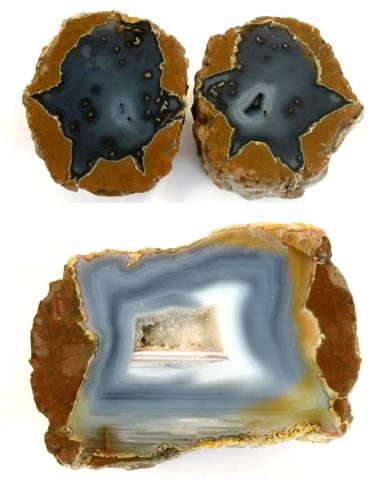
Oregon Thundereggs: Examples of thundereggs sawn to display their interior. The top two are halves of a single egg about three inches in diameter. It is filled with gray chalcedony with gray agate and drusy quartz in the center. The bottom is a half egg about six inches in diameter with gray banded agate around the outside, white agate towards the center, and a drusy quartz cavity in the center. Learn more about Oregon gemstones here.
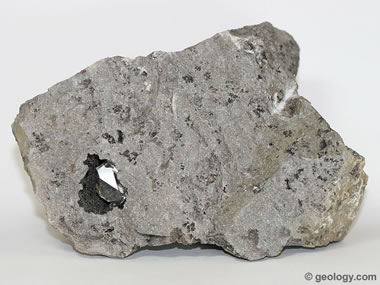
Herkimer diamond in a vug: A vug is an unlined cavity that will not remain when the rock that contains it weathers away. The famous doubly-terminated quartz crystals known as "Herkimer Diamonds" occur within vugs in the Little Falls Dolostone of Herkimer County, New York. The rock in the photo is about 18 centimeters across.
Geodes, Nodules, Vugs, Concretions and Thundereggs
Geodes, nodules, vugs, concretions and thundereggs are all sites in the earth where substances dissolved in subsurface waters precipitate to form crystals or rounded objects. These objects share many common features and form by similar processes. They all also produce objects that attract attention and stimulate debate. These objects are often confused with one another, and their names are used incorrectly because the speaker misunderstands the words or interprets the object incorrectly. They are also used in different ways by different people in various parts of the world. Who is right and who is wrong? Some generalizations drawn from the common usage of these words are offered below...
- Geodes have a hollow space inside, or once had a hollow space inside that was filled with precipitated mineral material. The precipitated mineral materials filled the cavity mainly through concentric inward growth. They have a competent external lining that allows them to separate from their host rock. This competent external lining allows many geodes to separate and survive after the host rock has been completely disintegrated by weathering. The geodes can then be collected from the land surface, dug from the soil, or found in stream beds.
- Nodules are solid objects composed of precipitated mineral material. They may have been hollow (and a geode) at one time, then completely filled with precipitated mineral material. They might also have formed by mineral growth on a sediment surface, growth within a cavity, or by replacement of their host rock.
- Vugs are cavities that might contain crystals, but they do not have a competent lining that allows them to separate from their host rock. Unlike many geodes, they probably will not exist after the host rock is weathered away.
- Concretions are solid aggregates composed of sediment grains and a cementing material. They form when chemical precipitation begins around a nucleus in the sediment, such as a fossil or a mineral grain. More and more material accumulates around the nucleus, and the concretion grows in three dimensions by filling in pore spaces and/or replacing mineral grains. Their growth starts in the center and they enlarge outwards without a cavity, whereas geode growth begins in a cavity and the minerals grow inwards.
- Thundereggs are spherical to subspherical masses of rhyolite that weather out of volcanic strata. They have an internal cavity that has been infilled with agate, opal or other mineral material. Thundereggs rarely contain mineral crystals growing into a void.
United States Geode Localities
A few areas in the United States are well-known for their geodes and geode-like objects. Geodes are so popular in a few states that they have achieved the status of "official state rock" or "official state gem." The Iowa State General Assembly designated the "quartz geode" as the official "state rock" in 1967. The Oregon Senate designated the Thunderegg as the official "state rock" in 1965. And, the Minnesota Legislature designated the Lake Superior agate as the official state gem in 1969. Some of the more noteworthy localities are described below. There are many more, and a good place to read about some of them is in a book titled Geodes: Nature's Treasures by Brad L. Cross and June Culp Zeitner.
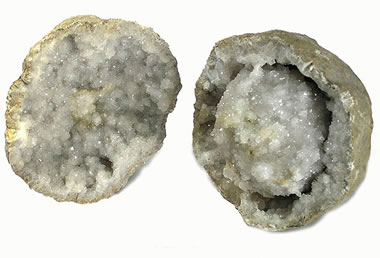
Keokuk geode from Lee County, Iowa. Specimen and photo by Arkenstone / www.iRocks.com.
Keokuk Geodes
One of the best-known occurrences of geodes in the world is an area surrounding the community of Keokuk, Iowa. It is located near the three-state intersection of Illinois, Iowa and Missouri, with geodes of this locality being found in all three states. The geodes formed in the limestones and dolomites of the Mississippian-age Warsaw Formation. Most of these geodes are a few centimeters across and have outer layers of white to gray to blue-gray chalcedony with interiors lined by tiny quartz crystals. Most of the geodes found here have weathered free of their carbonate host rock and are now in the local soils and stream sediments. A few of these geodes contain interesting crystals of ankerite, aragonite, calcite, dolomite, goethite, gypsum, kaolinite, marcasite, millerite, pyrite, sphalerite and other minerals. A few have been found with liquid petroleum inside. [1] [2]
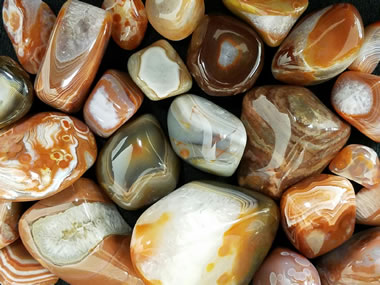
Lake Superior Agate: Some brightly polished tumbled stones made from Lake Superior agate nodules. They are usually completely filled with agate and/or crystalline quartz. These tumbled stones show some nice agate banding and often a crystalline quartz core. Specimens and photo by RockTumbler.com.
Lake Superior Agate
The Lake Superior agate is a fortification agate that fills cavities in basalt flows that formed over a billion years ago in the Lake Superior region. Over time, silica-rich groundwaters filled these cavities with agate and crystalline quartz. Most of them have been completely infilled and are more properly called a "nodule." However, some still retain a cavity that is often lined with crystalline quartz. The agate within them is typically reddish brown, red, and orangish red in color. These colors are caused by trace amounts of iron that was incorporated in the agate. Today they are found along beaches, in stream channels, in the soil of farmers’ fields and in glacial till. [3]
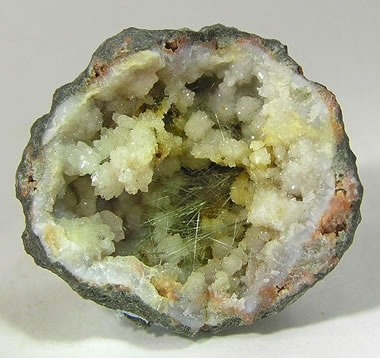
Kentucky geode with millerite. Specimen and photo by Arkenstone / www.iRocks.com.
Geodes of Kentucky
Parts of the Fort Payne and Warsaw-Salem Formations of Kentucky contain large numbers of geodes. These have weathered out of their host rock units and are now found in stream valleys. Other areas where numerous geodes are found in Kentucky stream valleys include the Green River in the south-central part of the state and along ancient terraces of the Kentucky River. [4]
Geodes of Wisconsin
The Geological and Natural History Survey of Wisconsin reports numerous occurrences of geodes, Lake Superior agate nodules, and thundereggs within the state. These have been in Ashland, Chippewa, Clark, Crawford, Douglas, Dunn, Grant, La Crosse, Milwaukee, Pepin, Pierce, St. Croix, Sheboygan, Trempealeau, and Washburn Counties. [5]
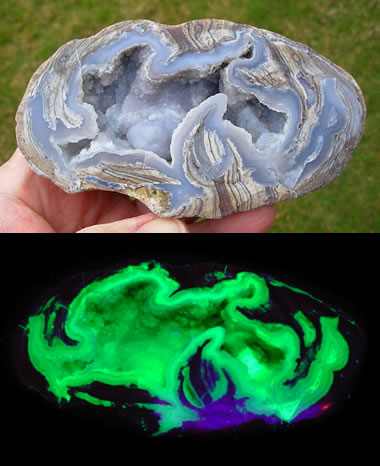
Fluorescent Dugway Geode: Many Dugway geodes contain fluorescent minerals and produce a spectacular display under UV light! Specimen and photos by SpiritRock Shop.
Dugway Geodes
One of the most interesting geode deposits in the United States is in Juab County, Utah. Between 32,000 and 14,000 years ago, Lake Bonneville covered much of what is now western Utah. Wave action along the shores of the lake eroded geode-bearing rhyolite flows. The wave action, along with weathering, liberated the geodes from the rhyolite and deposited them several miles away in lake sediments of what is now known as the Dugway Geode Beds. [6]
Today, lots of people search for Dugway geodes because they are thrilled to find their agate and crystal-lined centers. But, some of the Dugway Geodes contain another hidden surprise - trace amounts of uranium incorporated into their chalcedony lining cause the geode’s interior lining to exhibit a spectacular lime-green fluorescence under ultraviolet light. [7] See accompanying image. They probably get lots of fluorescent mineral collectors interested in geode collecting.
| Geode Information |
|
[1] Geodes: A Look at Iowa's State Rock by Brian J. Witzke. Iowa Geology, a publication of the Iowa Geological Survey Bureau, Number 12, 1987. Last accessed July 2022.
[2] Geodes: Small Treasure Vaults in Illinois: a page on the website of the Illinois State Geological Survey, Prairie Research Institute, last accessed July 2022. [3] State Gem: The Lake Superior Agate, by Scott F. Wolter, Minnesota Department of Natural Resources, Fact Sheet Number 113, March 1988. [4] Geodes: a page on the website of the Kentucky Geological Survey, University of Kentucky, last accessed July 2022. [5] Quartz: a page on the website of the Wisconsin Geological and Natural History Survey, last accessed July 2022. [6] Dugway Geode Beds, Juab County: by Carl Ege, a page on the website of the Utah Geological Survey, last accessed July 2022. [7] Dugway Geodes page on the SpiritRock Shop website, last accessed July 2022. [8] Geodes: One of Nature's Mysteries: GEONotes #23, a publication of the Indiana Geological Survey, Indiana University, last accessed July 2022. [9] The Gee!-Ode: What a weird hide, With such joy inside!: by Bob Jarrett, a page on the website of The Georgia Mineral Society, last accessed July 2022. [10] Thundereggs: Oregon's State Rock: a video on the Oregon Public Broadcasting website, last accessed July 2022. [11] Brazilian Elongated Amethyst Amygdules: by Dave Crosby, an article on the mindat.org website, last accessed July 2022. [12] Amethyst Mining in Brazil: by David Stanley Epstein, Gems & Gemology, Winter 1988 issue, pages 214-228. [13] The Origin of Large Gypsum Crystals in the Geode of Pulpi (Almeria, Spain): by A. Canals, A.E.S. Van Driessche, F. Palero, and J.M. Garcia-Ruiz; Geology, Volume 47, October 2019. [14] The Mystery of the Giant Crystals: How the 36-Foot Geode of Pulpi Formed: by Hannah Osborne, an article posted on the Newsweek website, October 16, 2019. |
Geodes of Indiana
In south-central Indiana geodes can often be seen in exposures of the Harrodsburg Limestone and Ramp Creek Formations. The Indiana Geological Survey reports that geodes are abundant along streams and scattered on the ground for several miles on either side of their outcrop areas. [8]
Woodbury Geodes
Woodbury geodes occur in the area around Woodbury, Tennessee. They originated in the limestones and dolostones of the Warsaw Formation and can be seen where these rock units are outcropping. Liberated geodes are found in residual soils above the rock units in which they formed, and in the sediments of the valleys that drain these areas. They are chalcedony-lined geodes with quartz crystal interiors. [9]

Stalactitic Gem Silica: A geode with stalactites of gem silica (inverted). From the Inspiration Mine, Gila County, Arizona. Specimen and photo by Arkenstone / www.iRocks.com. Learn more about Arizona gemstones here.
Arizona Gem Silica Geodes
Some unusual geodes and nodules found at the Inspiration Mine in Gila County, Arizona are lined with gem silica, a rare, beautiful and valuable form of blue chalcedony. Some have been found with gem silica stalactites!
Oregon Thundereggs
Thundereggs are not geodes, but they are so similar that they deserve at least one locality mention in this article. The state of Oregon is the most famous thunderegg locality in the world. Thundereggs are found in rhyolite and tuff deposits in many parts of the state. In 1965 the Oregon Legislative Assembly issued a resolution making the thunderegg the official state rock. The state has a thunderegg museum and locations where you can enter, pay a small fee, and look for thundereggs to take home. [10]
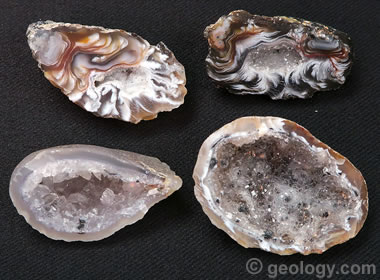
Oco Agate Geodes: Four oco agate geodes from Brazil. These geodes measure about 1 1/2 inches across. Click to view larger image.
Other Famous Geode Localities
There are hundreds of areas around the world where geodes of various types can be found in abundance. Most of these deposits are small and support the collecting activities of a few rockhounds. However, other deposits are extensive, with enough geodes to support a commercial collection and manufacturing industry.
Oco (Ocho) Geodes
Oco or Ocho geodes are small agate geodes with a drusy quartz lining that are found in the Tres Pinheiros region of Brazil. They range in size between about 1/2 and 3 inches in diameter and formed in the vesicles of basalt flows that underlie parts of this region. Most Oco geodes have a thin agate rind, an open interior, and an interior druse of tiny sharp quartz points about 1/8 inch long. Upon weathering, the basalt flow forms a reddish-brown soil and the geodes, being much more resistant to weathering than the basalt, accumulate in the soil.
When the deposits were first exploited, the geodes were easy to find and became a local business for people who collected and sold them. Many Oco geodes are sawn in half and polished, or are cut into slices and polished. These are sold in rock shops and novelty stores to people who enjoy interesting rocks and crystals. Because many Ocos have a very thin rind, they are often packaged and sold as "break a geode" kits. These are a popular activity for elementary students who are learning about minerals and crystals in a science class.
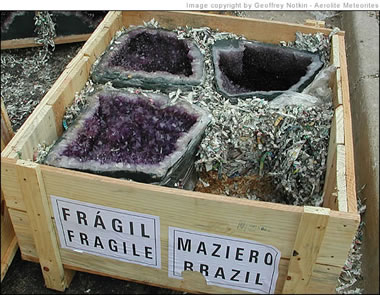
Huge Amethyst Geodes from Brazil. Image copyright by Geoffrey Notkin, Aerolite Meteorites.
Amethyst Amygdules of Brazil and Uruguay
Without question, the most spectacular geode deposit ever discovered is the amethyst amygdule basalts of Rio Grande do Sul region of Brazil and adjacent Uruguay. About 160 million years ago, when plate tectonic processes were rifting Africa and South America apart as the Atlantic Ocean opened, one of the world’s great flood basalt events was occurring. Basalts flowed from the rift, producing stratified lava flows thousands of feet thick.
Within these flows, gas bubbles and lava tubes created cavities that were first lined by a layer of agate, and then by a complete covering of coarse crystalline quartz. At this point the geodes were formed, but they were filled with rock crystal instead of amethyst. However, as these geodes remained buried, they were irradiated by the decay of radioactive minerals in the surrounding basalts. This radiation created color centers in the quartz, and that transformed the clear quartz into amethyst. The resulting geodes are beautiful and some are enormous. Today they are carefully mined, sawn and made into display pieces that serve as gemmy decor in homes, offices and museums. [11]
Some amethyst geodes are heated in a high temperature oven. This treatment causes the iron that is responsible for their purple color to oxidize. The result is a color transformation from amethyst quartz to citrine quartz.
The World's Largest Geode?
Geology.com has numerous articles about Earth Science World Records. These feature the world's tallest tsunami, world's largest volcano, world's tallest geyser and more. We have learned from these articles that picking the largest, tallest, deepest, etc. will be met with disagreements about measurement methods, qualifying criteria, and more.
Similar problems surround naming "the world's largest geode". The definition of a geode, the methods of measuring, the reliability of reports about large geodes - and more - make choosing the "largest" problematic. So, we are going to point to a geode that we think meets the definition and that is quite impressive in size. Some researchers have called it "the world's largest geode", and others disagree, but most can agree that this is a really big one.
The "Geode of Pulpi" is located near Almeria, Spain. It has a volume of approximately 11 cubic meters and a width of about 12 meters. It is hosted in Triassic dolostone, and it has a discontinuous mineral sequence that begins with iron-carbonates and barite, followed by celestine, and concluding with an internal cavity into which giant gypsum (selenite) crystals protrude. The gypsum crystals are colorless and transparent and are said to "look like blocks of ice". The geode was discovered in 1999 when it was intersected by a passage of the Mina Rica silver mine. [13] [14]
| More Geology Topics |
 |
Gold |
 |
Fossils |
 |
Landslides |
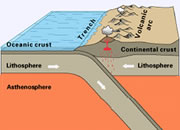 |
Plate Tectonics |
 |
Topo Maps |
 |
Metals |
 |
Gifts That Rock |
 |
General Geology |

Find Other Topics on Geology.com:

|

| ||

|

| ||

|

| ||

|

|

